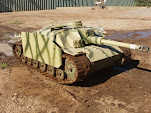This is the system I have come up with to rotate and elevate the gun. Once I have received the motors from www.robotmarketplace.com I will post a video of it doing its thing.
It's a fairly simple setup really, a motor for each axis rotating a shaft via chain... The whole system can be removed from the tank with 1 split pin for easy maintenance. As a stand alone system it can provide 45 degrees of depression, 45 degrees of elevation and 360 degrees of rotation. Mounted in the tank that movement is limited to 30 degrees of rotation 5 degrees depression and 15 degrees elevation.
Here it is, the tripod gets bolted to the tank floor, the shafts ride on 1/2"bronze bushings. The motors are mounted in the circular cut outs to the side and rear.

Negative elevation! almost looks like it's autonomous...

Mounted in the hull.

=Mr.TigerAce=



















